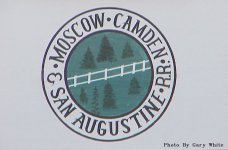
This site is non-profit and non-commercial. We are free of advertising on this site but there are costs in internet services. If you enjoy this site, we do need support.
Checks can be sent to: R. Donald Ross, 3821 Crater Lake Ct, Irving, TX 75062-4015

![]()

Don's Rail Photos

![]()
Moscow Camden & San Augustine RR

W. T. Carter & Bro. Lumber Co.
The Moscow, Camden and San Augustine Railroad Company was chartered on May 18, 1898, by William Thomas and Ernest A. Carter, who owned the W. T. Carter and Brother Lumber Company. The railroad was planned to connect Moscow in Polk County with San Augustine fifty miles to the east. The capital was $250,000, and the principal place of business was Camden. Members of the first board of directors were C. H. Jones of Galveston; J. E. McAshan of Houston, J. A. Handley, of Hortense; E. J. Mantooth of Lufkin; S. Bergman and D. L. Jones, both of Moscow; and W. T. Carter, E. A. Carter, and Jack Thomas, all of Camden. The line from Moscow to Camden, a distance of seven miles, was built for the railroad by the lumber company in 1899. W. T. Carter moved his operations to Camden where he had extensive timber holdings after a fire destroyed his sawmill at Barnum in 1897. The railroad connected the mill with the Houston East and West Texas Railway Company at Moscow. Although chartered to run as far east as San Augustine, the company only extended a short distance east of Camden where it intersected a tram line that brought logs from Camp Ruby. This connection formed a Y, which allowed the locomotives to be turned. The Moscow, Camden and San Augustine quickly paid for itself as it returned $56,500 in dividends during the first twenty years. Only $9,000 was paid out as cash dividends, the balance was a transfer from surplus in the profit and loss account to the credit of the open account with the various stockholders. This discharged their indebtedness for unpaid subscriptions. Due to the close relation of the railroad to the W. T. Carter and Brother Lumber Company, locals suggested that the initials on the side of the locomotive tender stood for "Mr. Carter and Sid Adams," the owner and longtime superintendent, respectively, of the sawmill. The Moscow, Camden and San Augustine never owned much rolling stock; for much of its history it only had one or two locomotives and a combination baggage-coach with space for express, passengers, and a desk for the conductor. Freight traffic, originally lumber from the sawmill and later supplemented by pulp wood or wood chips, was carried in cars provided by its connecting railroad. In 1903 the railroad reported passenger earnings of $500 and freight earnings of $15,000. By 1952 the amounts were $100 and $50,000, respectively. The railroad had an interesting operation at Moscow. The train was left on a hill outside of town while the locomotive was uncoupled and turned on a turntable for the return trip. Once this was done, the brakes were released on the cars which then coasted into a siding at the depot. This practice ended in April 1959 when the railroad leased a locomotive that was too large for the turntable. Instead of being turned at Moscow, it ran forward from Camden to Moscow and backed up on the return trip. Passenger service on the Moscow, Camden and San Augustine increased in the late 1950s, when a ride on the railroad's mixed freight and passenger train became somewhat of a tourist attraction. The railroad was also the last common carrier in Texas to use steam locomotives in regular service, but after 1965 only diesel engines were in use. Passenger revenues peaked in the early 1970s and were nearly $2,800 in 1972. However, passenger service was discontinued in July 1973 due to the age of the combine used to carry passengers, which dated from 1898, and the fear of potential accidents at the busy Highway 59 crossing near Moscow. In 1968 the Carter family sold the sawmill, timber lands, and railroad to what was then United States Plywood-Champions Paper, Incorporated. The railroad remains an active subsidiary of that company now known as Champion International, Incorporated.
BIBLIOGRAPHY: A Pictorial History of Polk County, Texas, 1846-1910 (Livingston, Texas: Polk County Bicentennial Commission, 1976; rev. ed. 1978).
George C. Werner
The railroad has been recognized with an historical marker.
1st 1 was built by Baldwin in November 1906, #29588, as Lufkin Land & Lumber Co 1. It became Shreveport Houston & Gulf RR 1 and transferred as Carter-Kelley Lumber Co 1 in 1913 It was sold as Carter 1 in 1936 and donated to Grigsby Foundation in 1970, It was leased as Scott & Bearskin RR 1 and later sold to Eureka Springs & North Arkansas as 1 in 1981.
2nd 1 was built by Baldwin in May 1925, #58413. It is now at the B-RI museum at Teague, TX, in 1970.
1st 2 was built by Lima on October 3, 1907, #2005, as Bering Kiam & Southern RR 2. In about 1920 it was sold as Carter 2 and sent on display for Stephen F Austin State Universidy in May 1970.
2nd 2 was built by Baldwin in January 1907. #29900, as LLLCo 2. It became SH&GRR 2 and transferred as C-KLCo 2 in 1913 It was sold as Carter 1 in 1936 and donated to Grigsby Foundation in 1970, It was leased as S&BRR 2 and it was sold as Reader RR 2 in May 1978. It does a few movie jobs.
3 was built by Baldwin in July 1908, #32846, as SH&GRR 3. It became C-KLCo 3 in 1913 and sold as Carter 3 in 1936. It was sent to the Texas Forestry Museum at Lufkin, TX,, in 1970.
4 was built by Baldwin in December 1913, #40958, as Laurel River Lumber Co. 22. It was sold as C-KLCo 4 and sold as Carter 4 in 1930. It was then donated to Grigsby Foundation in 1970. It was sold as Reader RR 4 in 1984 and leased to Mount Dora, Tavares & Eustis RR with various identifications. It was returned to Reader and does movie work.
5 was built by Baldwin in February 1911, #36130, as E P Rentz Lumber Co 101. It became SH&GRR 5 in 1913 and sold as Carter 5 in 1936. It was given to Polk County Museum in 1970.
6 was built by Baldwin in January 1911, #35816, as Carter 6. It was transferred as MC&SA 6 in August 1929 and was given to Texas Transportation Museum in 1970. It was lettered as Longhorn & Western RR.
14 was built by Baldwin in August 1923, #56917. as Rock Creek Lumber Co 14. It became Texas Long Leaf Lumber Co 14 and sold as Carter 14 in 1940. In 1970 it was offered to Rusk Chamber of Commerce and apparently was sold to City of Houston. It then was given to the Carter family at Camden.
201 was built by Alco-Cooke in January 1906, #39094, as Isthmian Canal Commission 203. It was sold to Equitable Equipment Co and sold as Carter 201 in 1922. It was transferred as MC&SA 201 in March 1929 and donated to Grisby Foundation in 1970. It was leased as S&BRL 201 and later sold to ES&NA as 201 in 1981.
17, 44 Ton, was built by General Electric in November 1944, #18183, as Pacific Electric Ry 1654, Class DS-205. It was transferred as Texas & New Orleans 17, Class DS-205, on November 1, 1958, and retired on June 30, 1960. It was sold on January 4, 1961, as MC&SA 17 and sold to George R Silcott Co in November 1971. It was then sold to Trans Car Services. There is no further information.
601, 70 Ton, was built by General Electric in January 1953, #31727, as Ahnapee & Western 601. In July 1971 it came to the MC&SA as 601. It was later sold to Econo Rail and scrapped in 2001.
3rd 1, SL110, was built by General Electric in October 1978. Disposition is not known.
4th 1, SW1200, was built by Electro-Motive in February 1954, #19491, as Texas & New Orleans 118, Class DF-401. It became Southern Pacific 2218, Class ES412-2, in 1965 and rebuilt at Houston as 2311, Class ES412E-2, on March 26, 1974. It later sold as MC&SA 1.
3, SW900, was built by Electro-Motive in April 1957, #23304, as Champion Paper Co 3. It became MC&SA 3.
A caboose is used as a business car.
The new shop.
The history came from The Handbook of Texas Online.
WebWork by
![]() rinity
rinity
![]() echnology
Co.
echnology
Co.
AMDG
12/3/2021
Memorial of Our Lady of Liesse
<><
Choose Life.
Mom did.
Home Page
Don's Depot
The adorable Heart of Jesus is our comfort, our way, our life.
---St. Frances Xavier Cabrini